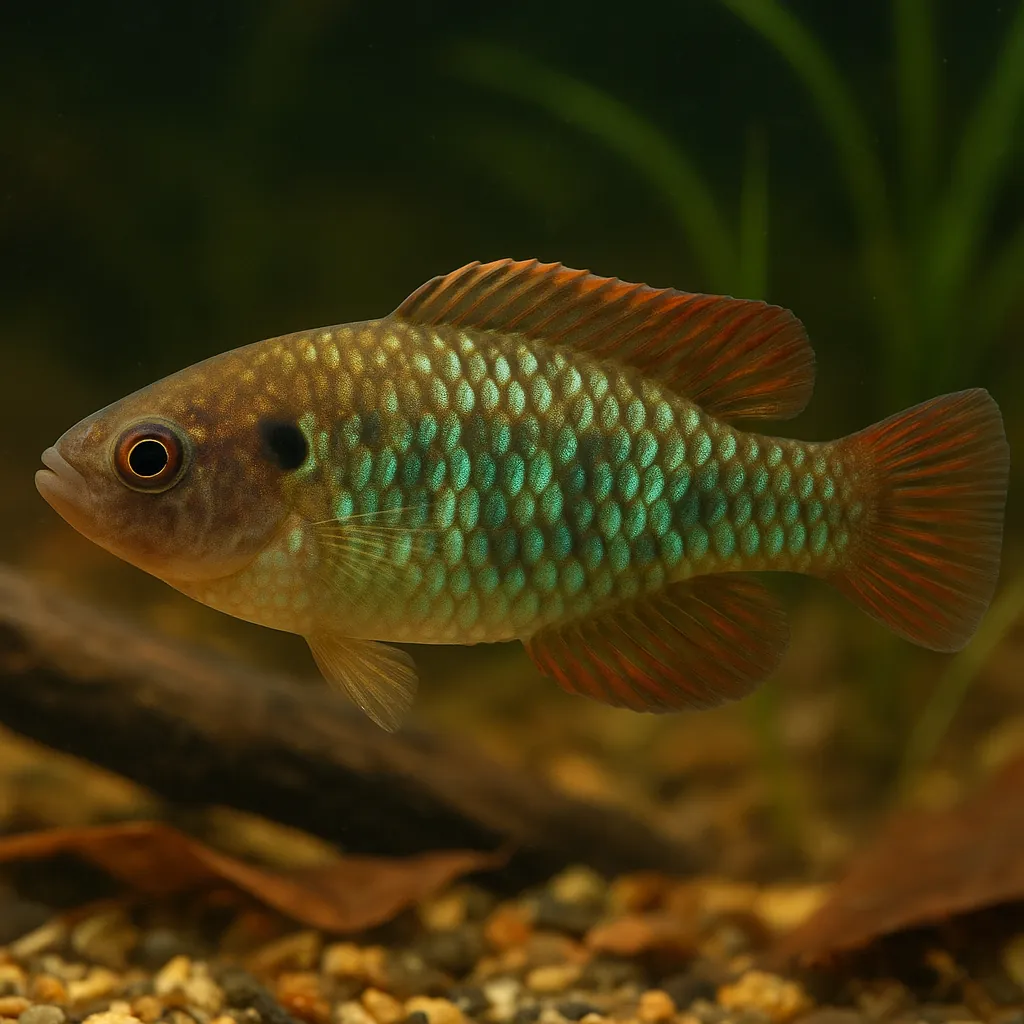
Flagfish
Introduction
The Flagfish, scientifically known as Jordanella floridae, is a captivating freshwater species native to Florida. Renowned for its vibrant coloration reminiscent of the American flag, this fish adds a unique aesthetic to home aquariums. Its hardy nature and algae-eating habits make it an excellent choice for both novice and intermediate aquarists seeking a low-maintenance yet visually striking addition to their tanks.
What makes the Flagfish a popular choice among aquarists?
Its resilience, combined with its ability to control algae growth, makes the Flagfish both a practical and attractive option for aquarium enthusiasts.
Is the Flagfish suitable for beginners?
Yes, due to its adaptability and straightforward care requirements, the Flagfish is well-suited for those new to fishkeeping.
Care and Environment
Proper care of the Flagfish involves attention to tank setup, water parameters, diet, and understanding its behavior.
What is the minimum tank size for a Flagfish?
A minimum of 40 liters (approximately 10 gallons) is recommended for a pair of Flagfish. For larger groups, a 75-liter (20-gallon) tank or more is ideal to provide ample space and reduce territorial disputes.
What are the ideal water conditions for Flagfish?
Flagfish thrive in temperatures between 19–23°C (66–73°F), with a pH range of 6.7–8.2, and water hardness between 12–18 dGH. They are adaptable but prefer stable conditions within these ranges.
How should the tank be set up for Flagfish?
A well-planted aquarium with dense vegetation, driftwood, and rocks mimics their natural habitat and offers hiding spots. A dark substrate can enhance their coloration. Ensure the tank has a secure lid, as Flagfish are known jumpers.
What type of filtration and lighting is best?
Use a low-flow filtration system, such as a sponge filter, to maintain water quality without creating strong currents. Moderate lighting supports plant growth and encourages natural behavior.
What should be included in the Flagfish's diet?
As omnivores, Flagfish require a balanced diet. They feed on algae, so supplementing with high-quality vegetable-based flakes or pellets is beneficial. Occasional offerings of blanched vegetables like spinach or zucchini, along with live or frozen foods such as brine shrimp or bloodworms, provide necessary protein.
Are there any specific challenges in keeping Flagfish?
While generally peaceful, males can become territorial, especially during breeding. Providing ample space and hiding spots can mitigate aggression. Additionally, their active nature may lead to fin-nipping of slower-moving or long-finned tank mates.
Origin and Habitat
Flagfish are endemic to Florida, inhabiting shallow, slow-moving freshwater environments such as marshes, ponds, and ditches. These habitats are typically well-vegetated, providing ample cover and feeding grounds. They have also been found in slightly brackish waters, showcasing their adaptability. The natural environment features soft substrates, abundant plant life, and minimal water flow, conditions that can be replicated in the home aquarium to promote their well-being.
Where are Flagfish naturally found?
They are native to the Florida Peninsula, thriving in various freshwater bodies with dense vegetation.
Can Flagfish tolerate brackish water?
Yes, they have been observed in slightly brackish environments, indicating a degree of tolerance to varying salinity levels.
Temperament and Compatibility
Flagfish exhibit a mix of peaceful and territorial behaviors. Males, in particular, can be aggressive towards each other and may display fin-nipping tendencies, especially during breeding seasons. To foster a harmonious community tank, consider the following:
Are Flagfish suitable for community tanks?
Yes, with careful selection of tank mates. They do well with active, similarly sized species that can handle their energetic nature.
What are ideal tank mates for Flagfish?
Suitable companions include livebearers like mollies and platies, tetras, and corydoras catfish. Avoid housing them with slow-moving or long-finned species to prevent fin-nipping.
How can aggression among Flagfish be managed?
Providing a spacious tank with plenty of hiding spots and visual barriers can help reduce territorial disputes. Keeping a higher ratio of females to males also minimizes aggression.
Interesting Facts
Beyond their care requirements, Flagfish possess several intriguing traits:
Why are they called Flagfish?
Their name derives from the male's coloration, which resembles the American flag, featuring red, white, and blue hues.
Do Flagfish help control algae?
Yes, they are known for their appetite for algae, including hair algae, making them beneficial for maintaining clean aquariums.
How do Flagfish reproduce?
They are egg layers, with females depositing eggs on various surfaces. Males often guard the eggs, though reports on parental care vary.
Sources
All information in this article has been gathered from the following reputable sources:
Overview
Recommended Tank Size 19.8 Gallons (for a pair; larger for groups) |
Minimum Group Size 2 |
Minimum Tank Volume 10.6 Gallons |
Maximum Adult Length 2.8 inches |
Average Adult Length 2.4 inches |
Shoaling (6+ required) No |
Preferred Water Type Freshwater, adaptable to slightly brackish |
Temperature Range (°C) 19–23 |
pH Range 6.7–8.2 |
Water Hardness (dGH) 12–18 |
Typical Lifespan (years) 3 years |